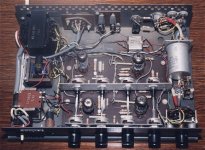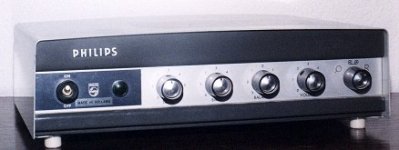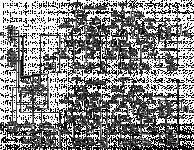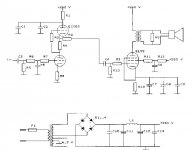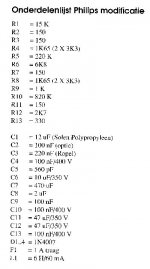I've purchased this 40years old philips AG9016 se stereo amp with 2xECC83 and 2xEL95. 2x2watts into 5 Ohms !
Just to see/hear what this talk about the 'magic' of tubes is all about.
I got home with the amp and connected it to my speakers (pied pipers) and cd player (philips cd850 mkII).
No big expectations. What can you expect from 2 watts (?). But I was completely amazed ! The small amp filled my livingroom of 34m2 completely with music (volume at 3/4) and it sounded excellent (my speakers must be quite sensitive!)! There really is something to this 'tube-magic' .....
No hum , no cracks - this amp is really silent.
The AG9016 has treble, bass, balance and volume control (and a loudness capacitor on the volumepot).
Imputs for ceramic pickup, tape and radio.
Although it already sounds great, I am convinced there are things that can be done to make it even sound better (everything except for the tubes, is 40 years old !).
Get rid of tone control, loudness cap?
New caps, resistors (which ones?)
Change input sensitivity?
I am a newbie in these tubes, so any help would be highly appreciated!
Schematic can be found here (i tried to attach it but it is too big) http://pjeantaud.free.fr/schemas/ag9016.zip (i hope he does not mind)
If there is anyone with more documentation, please feel free to send me a copy by email .....

Just to see/hear what this talk about the 'magic' of tubes is all about.
I got home with the amp and connected it to my speakers (pied pipers) and cd player (philips cd850 mkII).
No big expectations. What can you expect from 2 watts (?). But I was completely amazed ! The small amp filled my livingroom of 34m2 completely with music (volume at 3/4) and it sounded excellent (my speakers must be quite sensitive!)! There really is something to this 'tube-magic' .....
No hum , no cracks - this amp is really silent.
The AG9016 has treble, bass, balance and volume control (and a loudness capacitor on the volumepot).
Imputs for ceramic pickup, tape and radio.
Although it already sounds great, I am convinced there are things that can be done to make it even sound better (everything except for the tubes, is 40 years old !).
Get rid of tone control, loudness cap?
New caps, resistors (which ones?)
Change input sensitivity?
I am a newbie in these tubes, so any help would be highly appreciated!
Schematic can be found here (i tried to attach it but it is too big) http://pjeantaud.free.fr/schemas/ag9016.zip (i hope he does not mind)
If there is anyone with more documentation, please feel free to send me a copy by email .....
...Well, your amp was designed for higher impedence inputs than your CD player, so you could loose the input network circuits and apply the signal directly across the volume controls, which you could drop to a lower value (say 100k) and loose the compensation network...
You could also experiment in increasing the negative feedback from the output transformer, reducing the values from 1.5k. However, I suspect that to make any real difference to the frequency response you'd have to look at the output trannies, and so it depends on what you want to spend on a 40 year old amp giving a couple of watts per channel.
You could also experiment in increasing the negative feedback from the output transformer, reducing the values from 1.5k. However, I suspect that to make any real difference to the frequency response you'd have to look at the output trannies, and so it depends on what you want to spend on a 40 year old amp giving a couple of watts per channel.
Penq, this very good sounding amp was described in 2 issues of Audio&Techniek magazine several years ago. I have those issues. If I have the time I'll scan them and mail them if you leave your mailadress or if you contact me via the moderators.
They modified it twice and the results were pretty good. I had two AG9016's and I sure remember drilling holes for cinch connectors ! Very tough steel with a lot of carbon in it.
You'll have to change the high voltage caps anyhow. You'll be surprised what a difference that makes, they're definitely worn out after 40 years
They modified it twice and the results were pretty good. I had two AG9016's and I sure remember drilling holes for cinch connectors ! Very tough steel with a lot of carbon in it.
You'll have to change the high voltage caps anyhow. You'll be surprised what a difference that makes, they're definitely worn out after 40 years
Bournville,
Thanks for the input. As matter a fact the inputsignal are already directly applied to the volume controls. I have removed the loudness circuit (cap and resistor). I will certainly look into the other options. For now it seems to be a good thing to check the item that was published in AUDIO&TECHNIEK as Jean-Paul mentioned,
therefore,
Jean Paul,
This seems to be exactly what i'm looking for to get me going!
Indeed the quality of the housing is outstanding. Putting in cinch however really has to be done. Looking forward to this

If you find time to scan......? pthieme@home.nl
(would be highly appreciated !)
Netlist,
Any particular type/make I should use ?
BTW somebody was so nice to mail me the scans of the original documentation of 1963 !
Nice people on this forum.
Oh Joel,
What do you mean with #31 ?
Greetz
Peng
Thanks for the input. As matter a fact the inputsignal are already directly applied to the volume controls. I have removed the loudness circuit (cap and resistor). I will certainly look into the other options. For now it seems to be a good thing to check the item that was published in AUDIO&TECHNIEK as Jean-Paul mentioned,
therefore,
Jean Paul,
This seems to be exactly what i'm looking for to get me going!
Indeed the quality of the housing is outstanding. Putting in cinch however really has to be done. Looking forward to this
If you find time to scan......? pthieme@home.nl
(would be highly appreciated !)
Netlist,
Any particular type/make I should use ?
BTW somebody was so nice to mail me the scans of the original documentation of 1963 !
Nice people on this forum.
Oh Joel,
What do you mean with #31 ?
Greetz
Peng
Hi,
Just a case of wishful thinking?
Jean-Paul,
Seems you've been one of those A&T readers too?
I must have those modded circuits too.
One thing I can say with absolute certainty: in those days Philips really meant business when they said: "Let's make things better".
Nowadays I'm not too sure about that claim,
What's that with the 20 cm Hugo ? Are those caps that long ?
Just a case of wishful thinking?
Jean-Paul,
Seems you've been one of those A&T readers too?
I must have those modded circuits too.
One thing I can say with absolute certainty: in those days Philips really meant business when they said: "Let's make things better".
Nowadays I'm not too sure about that claim,
####
Hi,
If Joel doesn't mind...I know he will.
RCA type 31 or 231 is just a tiny power triode from the 1930s.
Delivering a fraction of a Watt if you're lucky and running downhill.
Hi,
What do you mean with #31 ?
If Joel doesn't mind...I know he will.
RCA type 31 or 231 is just a tiny power triode from the 1930s.
Delivering a fraction of a Watt if you're lucky and running downhill.
Whisful thinking
Did you ever see them?
/Hugo
I was referring to the very old caps that were labelled in cm instead of µF.jean-paul said:
What's that with the 20 cm Hugo ? Are those caps that long ?
Did you ever see them?
/Hugo
If you felt really ambitious, you could rebuild it to use 6AQ5s for 4.5W per channel... they would fit in the same sockets, but you would need an extra 6V 1A filament transformer as they use twice as much filament current. It would still be reasonably "authentic" however.
Post some pics!
Post some pics!
ShiFtY said:If you felt really ambitious, you could rebuild it to use 6AQ5s for 4.5W per channel... they would fit in the same sockets, but you would need an extra 6V 1A filament transformer as they use twice as much filament current.
Would be a big job to change it over though - the 6AQ5 (EL90) takes getting on for double the HT current of the EL95 at the same voltage (250), so a complete new power supply would be required. The output trannies would also have to be changed - apart from the risk of core saturation due to the higher HT current of the 6AQ5 the primary impedence of a transformer to match an EL95 (10,000 ohms) is double that of a 6AQ5. and of course, the bias resistors would need to be changed...
The use of the EL95 as a B7G output tube was popular for a time with Philips and Grundig, especially in use in tape recorders, whereas most other European manufacturers favoured the 6AQ5 (EL90) or the 6AM5 (EL91). Unfortunately, they are not easily interchangeable.
Shifty, Bournville,
Thanks, but I am really not thàt ambitious (well, not regarding this amp...)! Seems to be a very big task (too big for now, anyway). Still a newbie you see..... Besides, power is not really an issue at the moment. I am quite satisfied with the volume and the basic sound of this amp, it would just interest me to see if one could get more out of this amp with todays (higher quality (?))parts and more adjusted to todays equipment (cdplayer, speakers...). Changing to the other tubes seems to be a complete rebuild of the amp. I probably would rather build a new one from scratch if I wanted more power.
Here two pictures of the amp (not mine, this one already has the cinch-mod),
Greetz
Peng
Thanks, but I am really not thàt ambitious (well, not regarding this amp...)! Seems to be a very big task (too big for now, anyway). Still a newbie you see..... Besides, power is not really an issue at the moment. I am quite satisfied with the volume and the basic sound of this amp, it would just interest me to see if one could get more out of this amp with todays (higher quality (?))parts and more adjusted to todays equipment (cdplayer, speakers...). Changing to the other tubes seems to be a complete rebuild of the amp. I probably would rather build a new one from scratch if I wanted more power.
Here two pictures of the amp (not mine, this one already has the cinch-mod),
Greetz
Peng
Attachments
> <i>I am convinced there are things that can be done to make it even sound better</i>
Don't mess with success. It is a very-very-good amp as-is. It is low-power, not low-quality.
Clean the contacts and sockets, check the tubes for faults. If they sound fine, they probably are healthy. (By the way, nothing wrong with most 40 year old tubes, and they may be better-made than the ones knocked-out in the 1980s or 1990s. My 1968 PAS2 still has all original tubes. My over-worked Dyna Mk VI from 1975 has one bad tube.)
The power supply cap and rectifier may not live forever. I'm mildly surprised the main power cap didn't go "bang" at switch-on. For "fun" use, I'd use it until it failed, then fix it. For serious use, I'd get a handful of 100µFd 300V caps and a terminal-strip, yank the can and re-cap it. I just don't know about that rectifier, but if it fails a 1000V 1A bridge is an easy cheap replacement. Be sure the line-fuse is the correct size (if it has no line-fuse, I'd use 0.5A at 120VAC or 0.25A at 230VAC wall power) so if a cap or rectifier shorts, the precious power transformer does not go up in smoke.
The tone controls are a matter of taste. I would keep them, because it is authentic. However while the output stage is probably ruler-flat, the tone control stage may not be. You could bypass it: the combination of B1a and tone-circuits has only a small voltage gain. You could strap the volume pot wiper to the top of the balance control, with tone-circuit disconnected from balance pot, and still have good gain. But on a printed circuit board, that ain't easy. And I hate to see an oldie cut-up like that.
The rest of the amp is about as perfect as a 2-watter can get, assuming you like small-feedback SE Pentode. C12 might be upgraded to 100µFd 16V. If you touch any of the other caps, do not change their values without expert advice: they look like they were sized to control feedback stability. The resistors look like good-quality jobs and I would not touch them.
If you want less gain and less distortion, try R23=680Ω. But it may squeal or motorboat.
If you want more gain and honest tube distortion, try R23=10K. But speaker damping will be very poor.
If you want to try SE Triode, find the end of R22 that is not connected to the tube, lift it, and swing it over to connect to B2 pin 5 (plate). Power will be half, damping will be OK (though hardly up to modern expectations). Gain may be low, try R23=10K.
Mostly, I would fix any actual problems, then leave it alone and enjoy it for what it is.
> <i>Schematic (i tried to attach it but it is too big)</i>
Open it in a graphics editor and down-size it to no more than 600 pixels wide. Many schematics will not stand such reduction without getting blurry; this one does if you bump the contrast up. BTW, there is little point in ZIPping a GIF or JPG file (unless you need to trick a free web server, or want to keep several files together in a package). GIF and JPG are already compressed, ZIP won't make them smaller. For on-forum posting, it is nice to crop-off excess or redundant details: I omitted the second channel and the selector switch to make this (I hope this works...):
Don't mess with success. It is a very-very-good amp as-is. It is low-power, not low-quality.
Clean the contacts and sockets, check the tubes for faults. If they sound fine, they probably are healthy. (By the way, nothing wrong with most 40 year old tubes, and they may be better-made than the ones knocked-out in the 1980s or 1990s. My 1968 PAS2 still has all original tubes. My over-worked Dyna Mk VI from 1975 has one bad tube.)
The power supply cap and rectifier may not live forever. I'm mildly surprised the main power cap didn't go "bang" at switch-on. For "fun" use, I'd use it until it failed, then fix it. For serious use, I'd get a handful of 100µFd 300V caps and a terminal-strip, yank the can and re-cap it. I just don't know about that rectifier, but if it fails a 1000V 1A bridge is an easy cheap replacement. Be sure the line-fuse is the correct size (if it has no line-fuse, I'd use 0.5A at 120VAC or 0.25A at 230VAC wall power) so if a cap or rectifier shorts, the precious power transformer does not go up in smoke.
The tone controls are a matter of taste. I would keep them, because it is authentic. However while the output stage is probably ruler-flat, the tone control stage may not be. You could bypass it: the combination of B1a and tone-circuits has only a small voltage gain. You could strap the volume pot wiper to the top of the balance control, with tone-circuit disconnected from balance pot, and still have good gain. But on a printed circuit board, that ain't easy. And I hate to see an oldie cut-up like that.
The rest of the amp is about as perfect as a 2-watter can get, assuming you like small-feedback SE Pentode. C12 might be upgraded to 100µFd 16V. If you touch any of the other caps, do not change their values without expert advice: they look like they were sized to control feedback stability. The resistors look like good-quality jobs and I would not touch them.
If you want less gain and less distortion, try R23=680Ω. But it may squeal or motorboat.
If you want more gain and honest tube distortion, try R23=10K. But speaker damping will be very poor.
If you want to try SE Triode, find the end of R22 that is not connected to the tube, lift it, and swing it over to connect to B2 pin 5 (plate). Power will be half, damping will be OK (though hardly up to modern expectations). Gain may be low, try R23=10K.
Mostly, I would fix any actual problems, then leave it alone and enjoy it for what it is.
> <i>Schematic (i tried to attach it but it is too big)</i>
Open it in a graphics editor and down-size it to no more than 600 pixels wide. Many schematics will not stand such reduction without getting blurry; this one does if you bump the contrast up. BTW, there is little point in ZIPping a GIF or JPG file (unless you need to trick a free web server, or want to keep several files together in a package). GIF and JPG are already compressed, ZIP won't make them smaller. For on-forum posting, it is nice to crop-off excess or redundant details: I omitted the second channel and the selector switch to make this (I hope this works...):
Hi PRR,
Thanks for your trouble on the schematics!
Some usefull tips also.
Rest assured, I have no intention to mess around with the amp.... Just want to bring it a bit more up to date - without changing the design.
Everytime I listen to it, I'm quite amazed by the sound quality. We are not talking about some kind of special, expensive design, but just a series product for the masses and it still sounds better than many (expensive) amps you can buy today (40 years later !!). How come....... ?
Am already looking for some more adequate (high sensitive) speakers for this amp.
Some suggestions ? (full range single driver DIY ?)
Greetz,
Peng
Thanks for your trouble on the schematics!
Some usefull tips also.
Rest assured, I have no intention to mess around with the amp.... Just want to bring it a bit more up to date - without changing the design.
Everytime I listen to it, I'm quite amazed by the sound quality. We are not talking about some kind of special, expensive design, but just a series product for the masses and it still sounds better than many (expensive) amps you can buy today (40 years later !!). How come....... ?
Am already looking for some more adequate (high sensitive) speakers for this amp.
Some suggestions ? (full range single driver DIY ?)
Greetz,
Peng
AUDIO&TECHNIEK
Jean Paul,
I cannot seem to get in touch with you
As before I am still very interested in the articles from audio&techniek regarding this amp. My e-mail: pthieme@home.nl.
Look forward to hear from you.
Peng
Penq, this very good sounding amp was described in 2 issues of Audio&Techniek magazine several years ago. I have those issues. If I have the time I'll scan them and mail them if you leave your mailadress or if you contact me via the moderators.
Jean Paul,
I cannot seem to get in touch with you

As before I am still very interested in the articles from audio&techniek regarding this amp. My e-mail: pthieme@home.nl.
Look forward to hear from you.
Peng
- Status
- This old topic is closed. If you want to reopen this topic, contact a moderator using the "Report Post" button.
- Home
- Amplifiers
- Tubes / Valves
- 40 yrs old philips ag9016 se flea-power ?

 )
)
